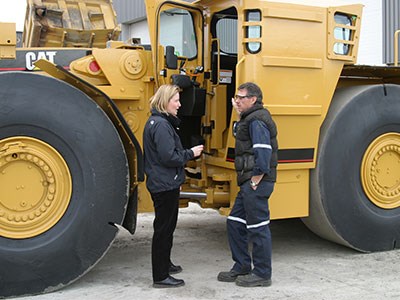Vibrations have not traditionally been recognized as major health and safety hazards in workplaces, but Laurentian University's Tammy Eger and her colleagues hope to change that perception.
“We're trying to get the message out that yes, vibration is an issue that can lead to medical problems, but there are control strategies in place to address them,” said Eger, director of the Centre for Research in Occupational Safety and Health (CROSH) at the university.
In January 2015, Eger will be appointed research chair in occupational health and safety.
On Dec. 2, she and other academics hosted a vibration workshop to inform representatives from different industries — including mining, fabrication and maintenance — about the risks associated with exposure to vibration, and how to reduce that exposure.
Whole body vibration — which starts at the feet, or buttocks from a seated position, and goes through the entire body — can lead to back pain and neck problems.
“Back injuries can get to the point where they're disabling,” Eger said.
Working on equipment that vibrates for extended periods — such as haul trucks, bulldozers and load-haul-dump machines — can even affect a person's internal organs.
“Sometimes operators will have problems with their gastrointestinal tract because their internal organs will vibrate at certain frequencies,” Eger said.
Mechanical interventions, including improved suspension and better seats, can help reduce exposure to harmful vibrations.
Protective gloves can also reduce exposure to high-frequency vibrations from certain tools.
As part of the Ministry of Labour's ongoing mining safety review, CROSH received two grants — one for $58,836 and the other for $49, 861 — to develop an inexpensive tool that can measure a worker's exposure to vibrations, and work on protective equipment, such as mats and special boots, to reduce vibrations.
Eger said vibrations while working at underground drill platforms can lead to blanching of the toes, decreased circulation, and neurological damage in the toes and feet.
Early research has suggested exposure to these vibrations can increase a worker's risk for slip or fall injuries.
CROSH has been working with STC Footwear of Montreal to test different boot materials and see how they reduce vibrations. Combined with other protective safety measures, such as mats, the boots could help reduce the effects from foot-transmitted vibration from underground mining equipment.
But while it has made a monetary commitment to research, the province does not have any legislation in place to regulate exposure to vibrations in the workplace.
At the Laurentian workshop some participants suggested organizational changes could reduce exposure to potentially damaging vibrations.
One participant said mining companies should reassess their bonus systems — which typically focus on production quotas — and incorporate more incentives that encourage health and safety.
Dr. Ron House, a researcher with the Centre for Research Expertise in Occupational Disease, affiliated with the University of Toronto and St. Michael's Hospital, treats patients who have been impacted by vibrations in the workplace.
Simply assessing that vibrations in the workplace have injured a worker is a difficult task that involves vascular tests, specific neurological tests and blood work, he said.
Pain at the upper extremities is a common symptom in people with prolonged exposure to vibrations, House said.
Cold temperatures often worsen their condition.
“Winter is very hard on these people,” he said. “We try to get them to reduce their exposure to cold ambient conditions. It's very hard in this country.”
A greater focus on prevention could prevent workers from visiting his office in the first place.
“The first step is awareness,” Eger said.




